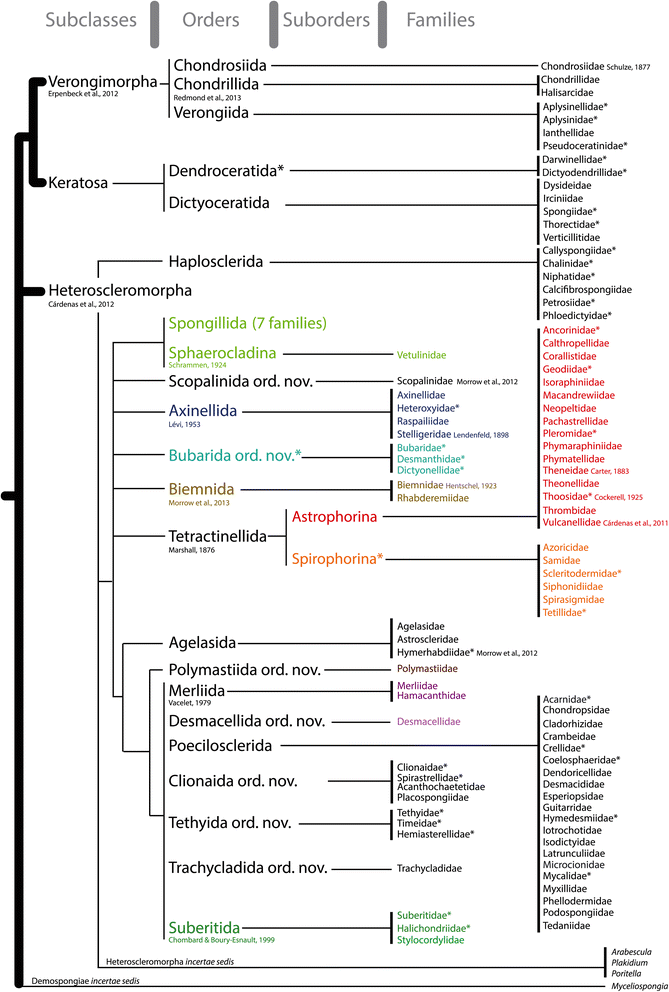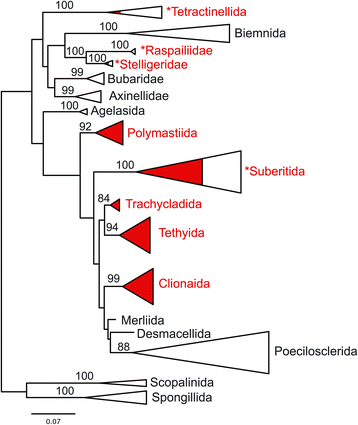Proposal for a revised classification of the Demospongiae (Porifera)
- PMID: 25901176
- PMCID: PMC4404696
- DOI: 10.1186/s12983-015-0099-8
Proposal for a revised classification of the Demospongiae (Porifera)
Abstract
Background: Demospongiae is the largest sponge class including 81% of all living sponges with nearly 7,000 species worldwide. Systema Porifera (2002) was the result of a large international collaboration to update the Demospongiae higher taxa classification, essentially based on morphological data. Since then, an increasing number of molecular phylogenetic studies have considerably shaken this taxonomic framework, with numerous polyphyletic groups revealed or confirmed and new clades discovered. And yet, despite a few taxonomical changes, the overall framework of the Systema Porifera classification still stands and is used as it is by the scientific community. This has led to a widening phylogeny/classification gap which creates biases and inconsistencies for the many end-users of this classification and ultimately impedes our understanding of today's marine ecosystems and evolutionary processes. In an attempt to bridge this phylogeny/classification gap, we propose to officially revise the higher taxa Demospongiae classification.
Discussion: We propose a revision of the Demospongiae higher taxa classification, essentially based on molecular data of the last ten years. We recommend the use of three subclasses: Verongimorpha, Keratosa and Heteroscleromorpha. We retain seven (Agelasida, Chondrosiida, Dendroceratida, Dictyoceratida, Haplosclerida, Poecilosclerida, Verongiida) of the 13 orders from Systema Porifera. We recommend the abandonment of five order names (Hadromerida, Halichondrida, Halisarcida, lithistids, Verticillitida) and resurrect or upgrade six order names (Axinellida, Merliida, Spongillida, Sphaerocladina, Suberitida, Tetractinellida). Finally, we create seven new orders (Bubarida, Desmacellida, Polymastiida, Scopalinida, Clionaida, Tethyida, Trachycladida). These added to the recently created orders (Biemnida and Chondrillida) make a total of 22 orders in the revised classification. We propose the abandonment of the haplosclerid and poecilosclerid suborders. The family content of each order is also revised.
Summary: The deletion of polyphyletic taxa, the use of resurrected or new names for new clades and the proposal of new family groupings will improve the comparability of studies in a wide range of scientific fields using sponges as their object of study. It is envisaged that this will lead to new and more meaningful evolutionary hypotheses for the end-users of the Demospongiae classification.
Keywords: Heteroscleromorpha; Lithistids; Monophyletic; Polyphyletic; Sponges; Systematics; Taxonomy; Type taxon.
Figures





References
-
- Hooper JNA, van Soest RWM. Systema Porifera: A guide to the classification of sponges. New York: Kluwer Academic / Plenum Publishers; 2002.
-
- World Porifera database, http://www.marinespecies.org/porifera [http://www.marinespecies.org/porifera]
-
- Morrow CC, Picton BE, Erpenbeck D, Boury-Esnault N, Maggs CA, Allcock AL. Congruence between nuclear and mitochondrial genes in Demospongiae: A new hypothesis for relationships within the G4 clade (Porifera: Demospongiae) Mol Phylogen Evol. 2012;62:174–90. doi: 10.1016/j.ympev.2011.09.016. - DOI - PubMed
LinkOut - more resources
Full Text Sources
Other Literature Sources
Miscellaneous

